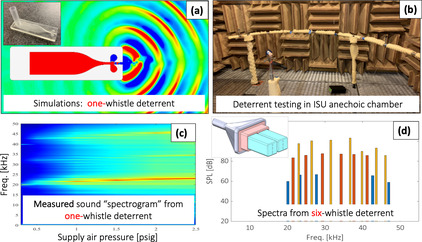Participants
Ultrasonic Bat Deterrents
Jamming their ultrasound signals through artificially-generated ultrasound can dissuade the bats from specific regions. This idea has been used in active’’ ultrasonic deterrents, e.g., by NRG. We are developing a blade-mounted, passive ultrasonic bat deterrent that generates acoustic power using blade-relative air flow. The fundamental idea is to use the instability of a shear layer and couple it with a resonator to generate high-intensity ultrasound. Tonal sound is generated at the desired frequency by tuning the geometry of the resonator. We have demonstrated both passive and active operation of our deterrent in anechoic wind tunnel and chamber.
Technology description
The ultrasonic bat deterrence technology developed at Iowa State University (ISU) is based on the concept of aerodynamic whistles — sound generated by flow instability and amplified using resonators — to produce high-intensity, tonal ultrasound spectra. An aerodynamic whistle is a self-sustaining oscillator that combines a fluid dynamic instability with a feedback mechanism to generate high-amplitude acoustic tones [Chanaud, 1970]. The dominant sound frequency of an aerodynamic whistle is determined by its feedback mechanism. Based on the feedback mechanism, Chanaud [1970] classified aerodynamic whistles into three classes. In Class I whistles, the feedback is provided directly by the flow instability. In Class II whistles, the feedback is provided by the sound generator, and in Class III whistles, the feedback is provided by the resonator/sound reflector. Our ultrasonic deterrents are Class III aerodynamic whistles that can produce multiple tones in the 20 kHz – 100 kHz frequency range. Tonal ultrasound can be generated very efficiently using aerodynamic whistles.
Two kinds of deterrents have been developed: (1) active, which are powered by compressed air and are intended to be mounted on turbine nacelle and/or tower, and (2) passive, which are mounted on rotor blades and driven by blade-relative air flow. The number and frequencies of the tones produced, and the spectral bandwidth can be tailored to the bat species of interest for both kinds of deterrents.
Active deterrents
Our active ultrasonic bat deterrents are powered by pressurized air. An active deterrent consists of multiple aerodynamic whistles. Each whistle is designed to target a specific ultrasound frequency and consists of three parts: (i) a panel on which the flow channel is engraved, (ii) a cover, and (iii) a circular supply pipe. These are 3D printed as an integrated piece using clear resin. High-pressure air enters the whistle through the supply pipe, passes through the throat of the channel, over the orifices of the two resonating chambers, and exits through the exit pipe.
Passive deterrents
Passive deterrents are designed to be mounted on wind turbine blades and use the blade-relative airflow to excite resonance at ultrasonic frequencies. They also use the concept of cavity resonance to generate a tonal spectrum. The resonance frequency can be modified by adjusting the geometry of the cavity.
Webinars
- 2023: REWI webinar
- 2021: AWWI webinar
Pictures
Publications
Journal
- Zeng, Z., & Sharma, A. (2023). Aerodynamic-whistles-based ultrasonic tone generators for bat deterrence. Physics of Fluids, 35(9). https://doi.org/10.1063/5.0160564
Conference proceedings
- Zeng, Z., & Sharma, A. (2022). Blade-mounted, passive ultrasonic bat deterrents for wind turbines. 28th AIAA/CEAS Aeroacoustics 2022 Conference, 3101. https://doi.org/10.2514/6.2022-3101
- Zeng, Z., & Sharma, A. (2021). Experimental and numerical aeroacoustic analysis of an ultrasound whistle. AIAA Aviation Forum. https://doi.org/10.2514/6.2021-2215

